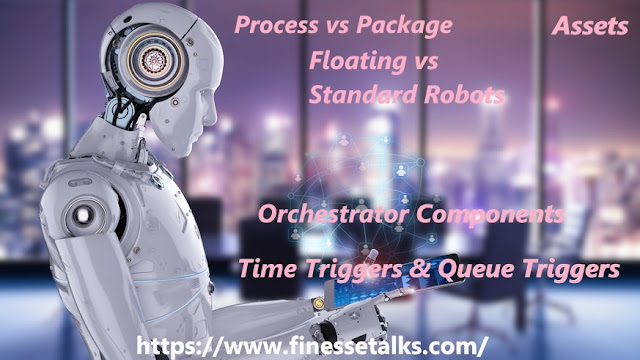Interview questions and answers for RPA - UiPath (Set 17)
Q- Explain main components of UiPath Orchestrator.
Some of the main components are explained below:
- Processes: A process represents the association between a package and an environment. Each time a package is linked to an environment, it is automatically distributed to all the Robot machines that belong to that environment.
- Assets: Assets usually represent secured shared variables or credentials that can be used in different automation projects. They give us the way to store specific information so that the Robots can easily have access to it.
- Queues: A queue is a container that enables us to hold an unlimited number of queue items. New queues created in Orchestrator are empty by default and can store multiple types of data.
- Schedules: Schedules enable us to execute jobs in a pre-planned manner, at regular intervals on Robots. Input values for processes which support input and output parameters can be managed at this level as well
- Robots: A Robot is an execution agent that runs processes built in UiPath Studio. The Robots page enables you to add robots, edit them, view their status and other related settings.
- Jobs: A job is the execution of a process on one or multiple Robots. After creating a process, the next step is to execute it by creating a job. When creating a new job, we can assign it to specific Robots.
Q- What do understand by Package and Process in Orchestrator?
The Packages page displays all the projects published from UiPath Studio, as well as the ones that were manually uploaded.
On this page, we can view and delete versions of all the packages that had been published from UiPath Studio, as well as those that were uploaded manually.
A process represents the association between a package and an environment. Each time a package is linked to an environment, it becomes available for all the Robot machines that belong to that environment.
The Processes page enables us to deploy an uploaded package to Robot environments, manage previously created associations and keep all your processes up to date. This helps us to distribute packages on the Robot machines and execute processes using Jobs.
Q- What is the difference between standard and floating Robot?
- Standard robot works on a single standard machine only, need to be defined during robot creation. There is a tight 1-1 mapping between machine and robot.
- Floating robot works on any machine defined in Orchestrator, as the robot is not tied to a specific machine.
- Only attended and development robots can be floating.
- We can convert a standard robot into floating robot by using convert to floating button.
Q- Explain Triggers and types of triggers.
Triggers enable us to execute jobs in a preplanned manner, at regular intervals (known as time triggers or scheduler) or whenever new items are added to the queues (known as queue triggers).
Two types of triggers are available in Orchestrator now, known to be "Time Triggers" and "Queue Triggers".
- Time Triggers – It enables us to schedule the job to start at recurrent time. We can also manage input and output parameters of the processes, if available, at this level as well.
- Queue Triggers – It enables us to trigger a process whenever new queue items are available in the queues. The trigger runs in the environment associated with the given process. Retried items do not count as new for queue triggers.
Q- What are the types of assets available in Orchestrator?
There are 4 types of assets available in UiPath Orchestrator, given below:
- Text
- Bool
- Integer
- Credential
Note: Fresher candidates can skip REFramework and/or Orchestrator based questions.




Comments
Post a Comment